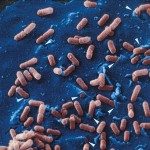Link to Pubmed [PMID] – 11890537
Int. J. Med. Microbiol. 2002 Feb;291(6-7):401-9
This review rather than covering the whole field, intends to highlight the particularly interesting properties of some proteins involved in the infection by Listeria monocytogenes and the general interest in some of the approaches used to analyze the molecular and cellular basis of the infection. After an introduction to the bacterium and to the disease, a description of the infection at the cellular level will be given. The specific features of the pore-forming toxin listeriolysin O, as a protein particularly well adapted to the intracellular lifestyle of L. monocytogenes will be discussed. By describing in detail how the bacterium moves inside cells, particular attention will be given to show how addressing this issue has provided key answers and instrumental tools to cell biologists studying actin-based motility. The analysis of the entry process and in particular the studies derived from the specificity of internalin for its receptor will demonstrate how an apparently reductionist approach can help generating relevant animal models, identification of virulence factors and demonstration of their role in vivo. The virulence gene cluster and its regulation by PrfA will be presented and discussed in the framework of the recently determined genome sequence.

